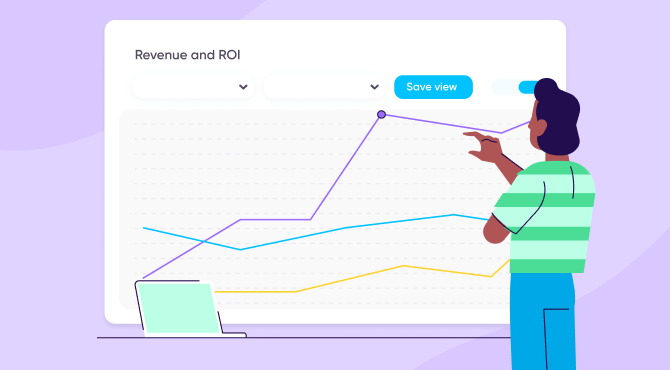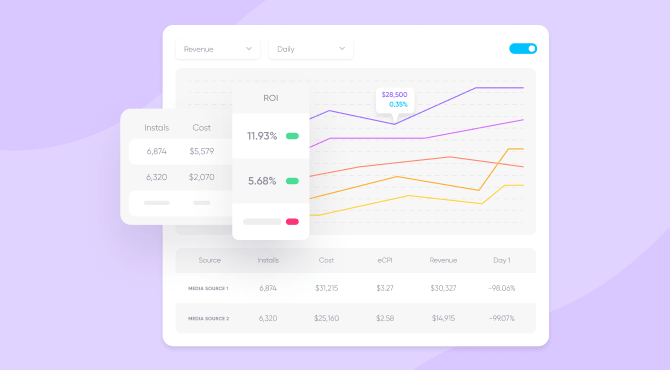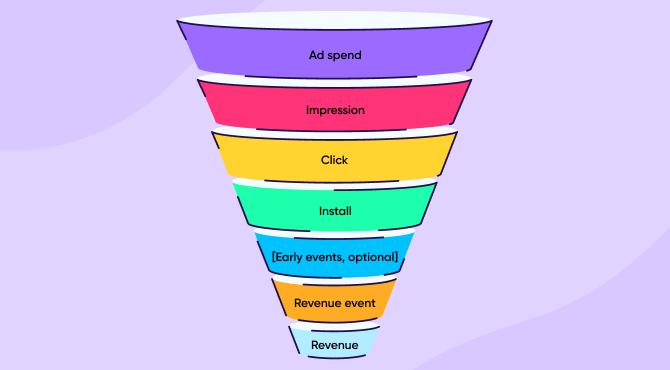
My ROAS is dropping! What should I do?

Navigating the ever-changing digital marketing landscape can be quite a challenge, especially when you need to prove the value of every single dollar you spend. This can be especially difficult when your Return on Ad Spend (ROAS) fluctuates: one day it’s positive, and the next, it’s negative. It’s the marketer’s dreaded ‘drop in ROAS.’
Some companies adopt different KPIs, for instance evaluating Cost Per Acquisition (CPA) instead of ROAS. There are different ways to look at data, but with similar outcomes: a drop in efficiency when ROAS decreases or CPA increases. This phenomenon is a persistent challenge that can send even the most seasoned marketers into a tailspin.
In this post, I’ll discuss practical steps to not only react swiftly but also correct course when confronted with the enigmatic ‘drop in ROAS.’ After all, adaptation is the key to survival in marketing.
Check out previous posts on the economic downturn by Thomas Petit, focusing on cash flow & payback periods (part 1, part 2) and how to cut smart.
Step 1: Don’t panic, know your dos and don’ts
When faced with a problem or a potential issue, don’t hit the panic button — it won’t help and only cloud your judgment.
Think about it: spotting a problem is a positive thing. It gives you the chance to address it, preventing it from escalating into a larger issue. And that’s certainly better than being unaware of a potentially significant problem.
In fact, you can turn the problem into a learning opportunity. For example, if someone else alerted you to the issue, use it as an opportunity to create alerts or notifications for future issues.
Be sure to inform relevant parties, including superiors, that you’re aware of the issue and actively working on it. Don’t discuss the problem prematurely and commit to providing updates once you’ve identified or fixed it — or require further assistance.
Then begin your investigation.

What to do
Before jumping into problem-solving mode, assess the situation’s severity. Don’t go into full-on crisis mode for a minor hiccup like a 3% decrease in ROAS in a single day. Focus on analyzing the bigger picture by examining your KPI trends over a longer time frame. Determine if the drop is a part of regular fluctuations or an abrupt and severe decline.
This initial analysis won’t provide a solution immediately. But it will help you better understand the urgency of the issue.
Remember, you don’t have to tackle the issue alone. Even with a well-defined process, it’s wise to get different perspectives, particularly from the channel’s UA manager, the data analyst, and the creative lead.
What NOT to Do
Refrain from seeking external help until you have a clearer understanding of your issue. If you jump on platforms like Reddit and ask for advice without providing context and details about your situation, others cannot give you meaningful assistance.
Also, resist the urge to start editing your campaigns right away. Automated ad platforms often respond poorly to frequent changes, and making too many adjustments when you’re uncertain about the problem may lead to worse results.
Instead, take the time to investigate and understand what’s happening before taking any action.
Step 2: Verify first — Is it real or just a mirage?
Before you rush into action, take a moment to ensure the problem you’re seeing is real. Is there a data problem, or is ROAS genuinely dropping? Data failures can occur frequently, especially with metrics that are modeled or have delays.
Data problems can include errors like overreporting of costs (sometimes they get counted twice) or underreporting of revenue due to issues with modeling or API interruptions.

It’s a good idea to cross-check with an independent source, if possible. For example, quickly look at your core revenue event in your product analytics tools. The less tied to the source you’re looking at, the better. Even if you don’t see the entire ROAS, this can provide valuable insights.
Before diving deeper, another early check could be to look at your app’s console (e.g., appstoreconnect or play console) for potential issues like high crash rates or other major failures. If it’s your app that’s acting up, not the network, that changes things.
Usually, I do this step a little later once I get a better understanding of the root causes, but you could also check with external sources and friends to see if this problem is widespread.
Check specialized communities and forums, or ask industry contacts. Sometimes, it’s not your ROAS but a bigger issue like a SKAN malfunction or a Facebook API glitch causing double costs that’s causing the apparent ROAS drop.
In that case, it might turn out that nothing is actually affecting your ROAS directly.
Step 3: Identify the root cause — slice and dice
If indeed there’s a real drop in performance, it’s time to dig into the data to find out why it’s happening.
The goal here is simple: find out where this drop is coming from. To do that, you’re going to “slice and dice” the data, which means breaking it down into smaller parts using metrics and dimensions.
Whether you’re using a raw report, a dashboard from a mobile measurement partner (MMP), a fancy business intelligence tool, a simple data visualization tool, or just good old Excel, your best pals right now are filter & pivot.
Dimensions (segments)
When analyzing your ROAS, you should consider various dimensions to pinpoint the root cause of issues so you can understand if the drop is specific or across the board on various levels: OS, media source, geo, campaign (and deeper into ad group and creatives).
By now, you should have a pretty good idea if this drop is:
- If there’s a problem on both platforms and/or all sources, it’s unlikely to be from a change in an ad network or paid user acquisition. It’s probably something in the app. Also, check if there was a new app release around the time the drop started.
- If it’s specific to a network and platform, but everything else is stable, focus your analysis there, filter this network only and keep digging.

Not all dimensions can report ROAS; for example, costs might not be available by OS version or device family. In such cases, you may need to work with what’s available. Compare the Average Revenue Per User (ARPU) of the latest release with previous ones.
Steps of the funnel
To optimize your strategy, it’s essential to break down your funnel into intermediary steps both before and after implementing changes. This process helps you identify which part might be causing a decline in your ROAS.
Any standard funnel looks like this:

To pinpoint the root cause of ROAS decline, you need to examine each conversion rate (think: Click-Through Rate, Install Rate, Install to Paying Event Rate, and Average Revenue Per Paying User) and determine the cost associated with each step (think: Cost Per Mille impressions, Cost Per Click, Cost Per Install, and Cost Per Acquisition).
The metrics we’re looking at should be analyzed over time to understand the magnitude, and whether it’s a sudden or gradual change.
By comparing the performance before and after the drop in ROAS, you can identify which particular step is degrading, giving you valuable insights into the issue at hand. While there may be changes across various steps, focusing on the step with the most significant drop can help you address the main culprit behind the ROAS decline.
Step 4: Figure it out — understanding the root cause
When you identify a drop in performance or encounter an issue, it’s essential to dig deeper and understand why it happened. This process involves making educated guesses or hypotheses about what might be causing the problem.
What you do next depends on what the problem is. Let’s look at some examples:
Example 1: Cost Per Install (CPI) is rising sharply, but only on Facebook for iOS
If the cost of getting people to install an app (CPI) is going up only on Facebook for iPhone users, you need to figure out why.
One possibility is that the number of installs per thousand (IPM) has gone down. This could be because fewer people are clicking on the ads (CTR), or because it’s harder to measure installs — or both.
To start fixing this, make sure the data you’re using to measure installs (SKAN data) is correct. Then, check if things like where the ads are shown (placements breakdown)or which creatives get the most money have changed.
It might also be that some ads are getting old and don’t work as well anymore, (creative fatigue) so you might need to stop using them.
Another thing to consider is whether this CPI increase is because you’re advertising in a place where it’s more expensive to get installs. If that’s the case, adjust your advertising to focus more on countries where it’s more cost-effective to get installs. and even more importantly revenue events.
Example 2: CPI is pretty stable, but conversions to revenue have plummeted on a specific ad network
When you notice that the conversion to revenue event on a specific ad network has suddenly dropped, there could be several reasons behind it.
First, it might be due to errors in the modeling or missing data, especially if the network reports data with a delay, like the SKAN report on Google App Ads. This could lead to skewed results or incorrect reporting. Another possibility is that changes in event schemas or updates to SDKs (like Facebook’s) might affect reporting on that specific network.
It’s essential to compare this network’s performance with others. If all sources are impacted, it could be related to a product change or experiment. Once you’ve ruled out these factors, it’s time to dig deeper within the problematic ad network.
Check if the distribution of publishers is similar to the previous period. You might be buying traffic from an app that’s harming your revenue conversion. In response, you can consider adding the publisher to an exclusion list, moving it to another campaign, or adjusting the bid for that specific source to address the issue effectively.
The bottom line: Adopt a diagnostic-first approach
Remember, before taking any action to address a problem, conduct tests or assessments to pinpoint the root cause so you can determine the most effective solution.
Once you’ve identified the issue, the remedy can vary widely. It might involve actions like pausing certain campaigns, reallocating your budget, fixing technical glitches on your website, updating product descriptions and keywords, refreshing your marketing materials, or implementing other strategies.
Making impulsive decisions without a clear diagnosis can lead to unfavorable outcomes, so it’s essential to follow a diagnostic-first approach to take the right course of action.

Key takeaways
- Don’t panic when you encounter a degradation in your ROAS. First, ensure it’s a real issue, not just a blip in the data. Then gauge the extent of the problem. Is it a minor dip, or is it a major setback?
- Use the “slide and dice” approach to narrow down the problem. Identify specific segments and steps in your funnel where the issue is most pronounced and compare over time.
- Only after pinpointing the problem should you start forming hypotheses about why it’s happening. This leads to informed actions tailored to the specific issue.
- A decreasing ROAS, when identified early and specifically, is an opportunity for improvement, not a disaster. Take this chance to analyze, refine, optimize, reallocate resources, and closely monitor your marketing efforts.




